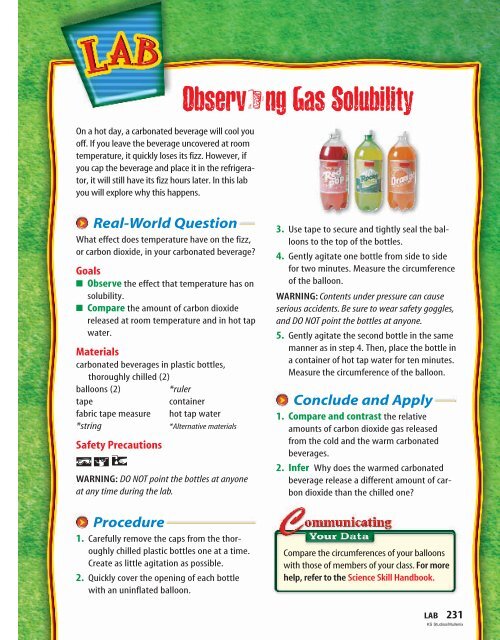Substances, Mixtures, and Solubility - McGraw-Hill Higher Education
Substances, Mixtures, and Solubility - McGraw-Hill Higher Education
Substances, Mixtures, and Solubility - McGraw-Hill Higher Education
You also want an ePaper? Increase the reach of your titles
YUMPU automatically turns print PDFs into web optimized ePapers that Google loves.
On a hot day, a carbonated beverage will cool you<br />
off. If you leave the beverage uncovered at room<br />
temperature, it quickly loses its fizz. However, if<br />
you cap the beverage <strong>and</strong> place it in the refrigerator,<br />
it will still have its fizz hours later. In this lab<br />
you will explore why this happens.<br />
Observeng Gas <strong>Solubility</strong><br />
Real-World Question<br />
What effect does temperature have on the fizz,<br />
or carbon dioxide, in your carbonated beverage<br />
Goals<br />
■ Observe the effect that temperature has on<br />
solubility.<br />
■ Compare the amount of carbon dioxide<br />
released at room temperature <strong>and</strong> in hot tap<br />
water.<br />
Materials<br />
carbonated beverages in plastic bottles,<br />
thoroughly chilled (2)<br />
balloons (2)<br />
*ruler<br />
tape<br />
container<br />
fabric tape measure hot tap water<br />
*string<br />
*Alternative materials<br />
Safety Precautions<br />
WARNING: DO NOT point the bottles at anyone<br />
at any time during the lab.<br />
Procedure<br />
1. Carefully remove the caps from the thoroughly<br />
chilled plastic bottles one at a time.<br />
Create as little agitation as possible.<br />
2. Quickly cover the opening of each bottle<br />
with an uninflated balloon.<br />
3. Use tape to secure <strong>and</strong> tightly seal the balloons<br />
to the top of the bottles.<br />
4. Gently agitate one bottle from side to side<br />
for two minutes. Measure the circumference<br />
of the balloon.<br />
WARNING: Contents under pressure can cause<br />
serious accidents. Be sure to wear safety goggles,<br />
<strong>and</strong> DO NOT point the bottles at anyone.<br />
5. Gently agitate the second bottle in the same<br />
manner as in step 4. Then, place the bottle in<br />
a container of hot tap water for ten minutes.<br />
Measure the circumference of the balloon.<br />
Conclude <strong>and</strong> Apply<br />
1. Compare <strong>and</strong> contrast the relative<br />
amounts of carbon dioxide gas released<br />
from the cold <strong>and</strong> the warm carbonated<br />
beverages.<br />
2. Infer Why does the warmed carbonated<br />
beverage release a different amount of carbon<br />
dioxide than the chilled one<br />
Compare the circumferences of your balloons<br />
with those of members of your class. For more<br />
help, refer to the Science Skill H<strong>and</strong>book.<br />
LAB 231<br />
KS Studios/Mullenix

















